
Free France was a political entity claiming to be the legitimate government of France following the dissolution of the Third Republic during World War II. Led by General Charles de Gaulle, Free France was established as a government-in-exile in London in June 1940 after the Fall of France to Nazi Germany. It joined the Allied nations in fighting Axis forces with the Free French Forces, supported the resistance in Nazi-occupied France, known as the French Forces of the Interior, and gained strategic footholds in several French colonies in Africa.
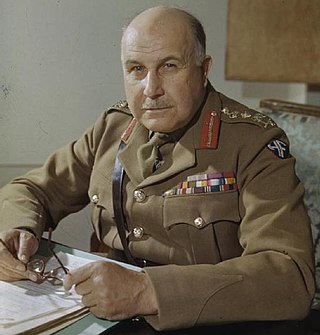
Field Marshal Henry Maitland Wilson, 1st Baron Wilson,, also known as Jumbo Wilson, was a senior British Army officer of the 20th century. He saw active service in the Second Boer War and then during the First World War on the Somme and at Passchendaele. During the Second World War he served as General Officer Commanding-in-Chief (GOC-in-C) British Troops in Egypt, in which role he launched Operation Compass, attacking Italian forces with considerable success, in December 1940. He went on to be Military Governor of Cyrenaica in February 1941, commanding a Commonwealth expeditionary force to Greece in April 1941 and General Officer Commanding (GOC) British Forces in Palestine and Trans-Jordan in May 1941.
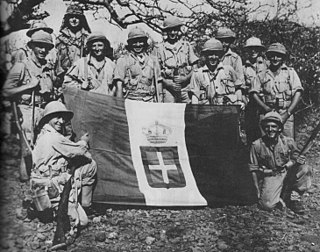
The East African campaign was fought in East Africa during the Second World War by Allies of World War II, mainly from the British Empire, against Italy and its colony of Italian East Africa, between June 1940 and November 1941. The British Middle East Command with troops from the United Kingdom, South Africa, British India, Uganda Protectorate, Kenya, Somaliland, West Africa, Northern and Southern Rhodesia, Sudan and Nyasaland participated in the campaign. These were joined by the Allied Force Publique of Belgian Congo, Imperial Ethiopian Arbegnoch and a small unit of Free French Forces.

Middle East Command, later Middle East Land Forces, was a British Army Command established prior to the Second World War in Egypt. Its primary role was to command British land forces and co-ordinate with the relevant naval and air commands to defend British interests in the Middle East and eastern Mediterranean region.

Henri Louis Honoré, comte d'Estienne d'Orves was a French Navy officer and one of the major heroes of the French Resistance, said to be the "first martyr of Free France".

Georges Thierry d'Argenlieu, in religion Father Louis of the Trinity, OCD, was a Discalced Carmelite friar and priest, who was also a diplomat and French Navy officer and admiral; he became a major personality of the Forces navales françaises libres. He was the chancellor of the Ordre de la Libération.
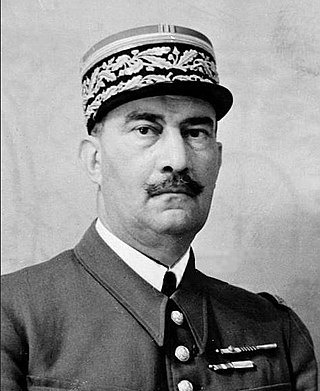
Henri Fernand Dentz was a general in the French Army who served with the Vichy French Army after France surrendered during the Second World War. He was tried as a collaborator after the war.
Gabriel Brunet de Sairigné was a French Army officer of the French Foreign Legion. He was born in Paris, and was killed in the line of duty close to Lagnia Bien Hoa (Vietnam).

The Allied leaders of World War II listed below comprise the important political and military figures who fought for or supported the Allies during World War II. Engaged in total war, they had to adapt to new types of modern warfare, on the military, psychological and economic fronts.

The 1st Free French Division was one of the principal units of the Free French Forces (FFL) during World War II, renowned for having fought the Battle of Bir Hakeim.
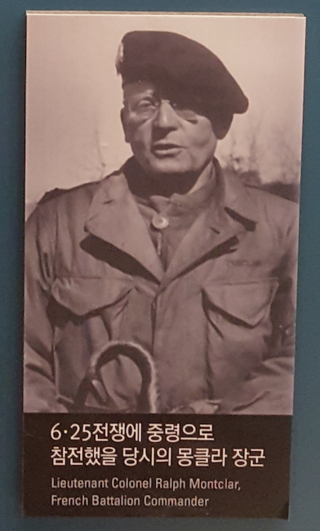
Raoul Charles Magrin-Vernerey, also known as Ralph Monclar was a French officer and 2nd Inspector of the Foreign Legion who fought in World War I, World War II within the ranks of the Free French Forces and led the French Battalion in the Korean War. He was also one of the first senior officers to respond to the Appeal of 18 June.

Jean-Baptiste Piron was a Belgian military officer, best known for his role in the Free Belgian forces during World War II as commander of the 1st Belgian Infantry Brigade, widely known as the "Piron Brigade", between 1942 and 1944.
René Jacques Adolphe Prioux was a French general who served in both world wars. A cavalry officer of great talent, Prioux rapidly rose through the officer ranks and commanded the Cavalry Corps of the First Army during the Battle of Belgium in May 1940. He was captured by the Germans and spent two years as a prisoner of war. Repatriated in 1942, Prioux came to be seen as a strong supporter of the Vichy regime and was consequently removed from a position of authority in the French Army by Charles de Gaulle, the leader of the Free French, after the landings in French north Africa by U.S. and British forces in November 1942.
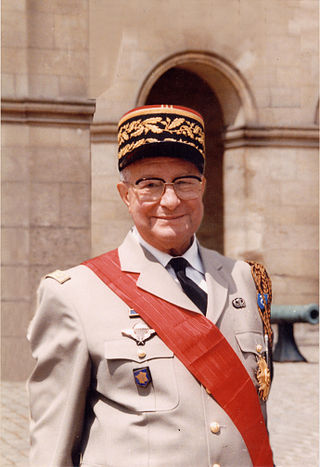
Jean Compagnon was a French officer and Général de corps d'armée.
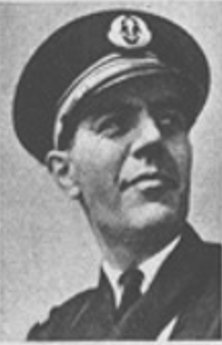
Philippe Marie Joseph Raymond Auboyneau was an officer in the French Navy. As an admiral, he was commander of the Free French naval forces in the Pacific and the Mediterranean during the Second World War. He was awarded the Ordre de la Libération for his service to the country.

French Somaliland, with its capital at Djibouti, was the scene of only minor skirmishing during World War II, principally between June and July 1940. After the fall of France the colony was briefly in limbo until a governor loyal to the Vichy government was installed on 25 July. It was the last French possession in Africa to remain loyal to Vichy, surrendering to Free French forces only on 26 December 1942. Pierre Nouailhetas governed the territory through most of the Vichy period. After aerial bombardment by the British, he instituted a reign of terror against Europeans and locals. Nouailhetas was eventually recalled and forced to retire. From September 1940, the colony was under an Allied blockade, and many of its inhabitants fled to neighbouring British Somaliland. After the territory's liberation, there were many governors and recovery from the deprivation of 1940–42 was only beginning when the war ended in 1945.

Jean-Marie Querville, was a French Navy officer of the Free French Naval Forces, a Compagnon de la Libération, became the Commander-in-Chief for the Mediterranean, then Maritime Prefect, following as an inspector general of the Marine Nationale and admiral.

Gabriel Bablon was a French army officer and Compagnon de la Libération. A Legion Officer seconded from the ranks, who had already accumulated more than fifteen years of service, when the Second World War began, he refused defeat and continued fighting in the ranks of the Free French Forces. Engaged in the Western Desert Campaign, he illustrated capability during the Battle of Bir Hakeim and the Second Battle of El Alamein. Later he participated to the Italian campaign and the Liberation of France. Pursuing later his military career after the war, he served in Indochina and in Germany before retiring.
Mohamed Bel Hadj was an Algerian-French army lieutenant and French resister. He distinguished himself by switching sides from Vichy to Free French forces after becoming injured in Lebanon and saving his unit commander during fighting in Libya. He was mortally wounded by a landmine while leading an operation in eastern France.
Robert Détroyat was a French naval officer and Compagnon de la Libération. He served in the French Navy before joining the Free French Forces. He was the cousin of French aviator Michel Détroyat.
















